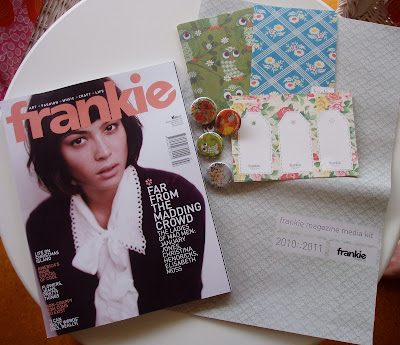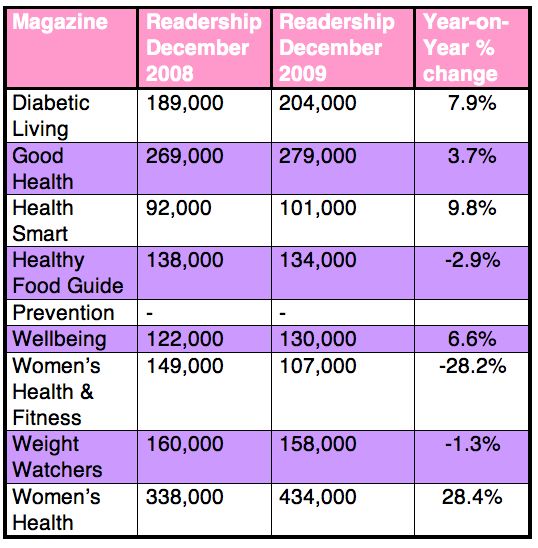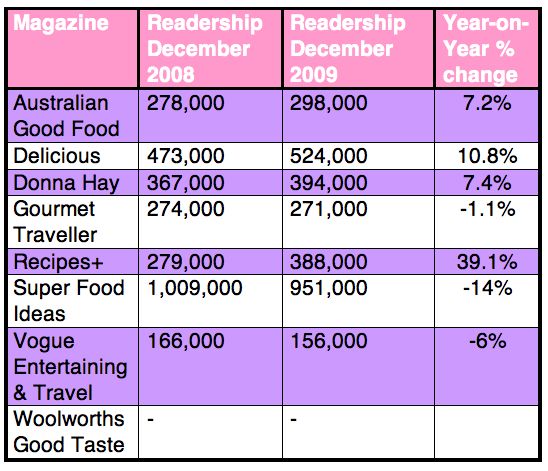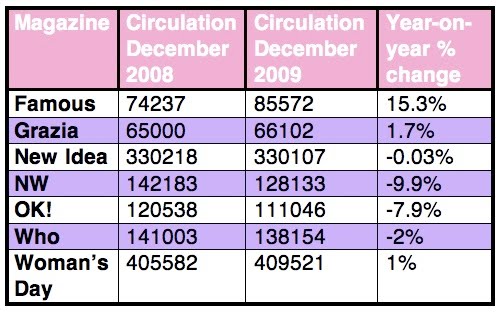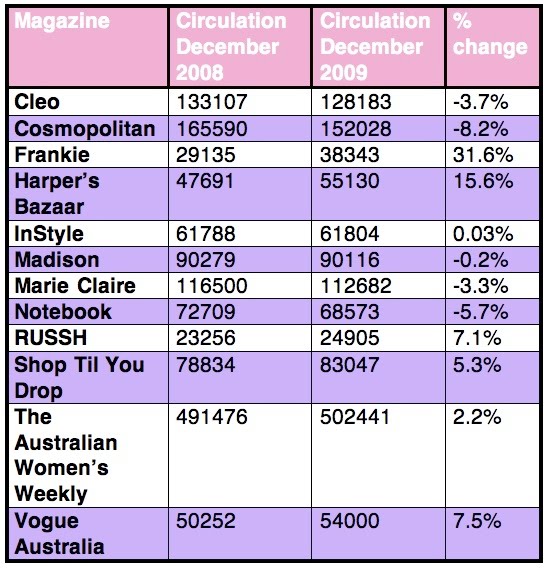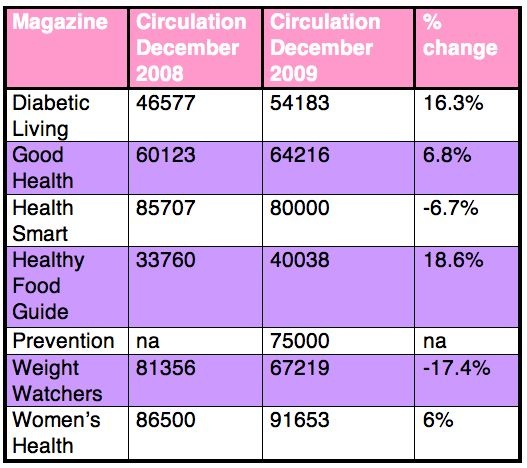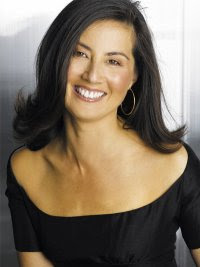 Girl Talk: Through the glossy looking glass (everyone is impossibly thin and fabulous!)
Girl Talk: Through the glossy looking glass (everyone is impossibly thin and fabulous!)
While we're still getting our heads around the spring/summer collections celebrated in the glossies on stands now (produced three months ago), the fash pack has its attention focused on New York for Mercedes-Benz Fashion Week's fall collections (see Clare Press' "Chictionary" explanation of the crazy fashion cycle... no wonder caffeine and dark glasses are a f'row necessity).
In light of Fashion Week, the CFDA (Council of Fashion

Designers America) held a discussion about body image entitled "The Beauty of Health: Resizing the Sample Size" (as reported by Sally Holmes for
The Cut). On the panel were casting agent James Scully, model Doutzen Kroes and designer Zac Posen.
Scully talked of the unhealthy practises used by models wanting to stay in the business: a business that currently demands them to be skinny. Very skinny. Like
Vogue Australia covergirl and current catwalk favourite Abbey Lee Kershaw, 22, who has lost a lot of weight since I cast her in a beauty shoot in 2006.
Kershaw talked to
Today Tonight this week (see the clip at
Frockwriter) about what it takes to stay at the top of the fashion model game: "An elite performer is always put under some sort of extreme pressure that the rest of society can argue and not quite understand."
It's this idea, that the fashion world is quite separate from the rest of society, ensconced in a glossy bubble where everyone is impossibly thin, chic and fabulous, and where different rules apply, that prompted
Harper's BAZAAR Australia editor Edwina McCann to explain in her March editor's letter:
"
There's always debate about the role the fashion  industry plays in shaping young women's minds and, most importantly, their opinions of themselves. Mostly, the judgments are negative, with fashion image makers and creators blamed for, well, just about everything. I don't want to make light of this subject, especially with regard to body image, but it strikes me how foreign this perception of fashion in the media is, for me anyway. It's just not the way I see my world
industry plays in shaping young women's minds and, most importantly, their opinions of themselves. Mostly, the judgments are negative, with fashion image makers and creators blamed for, well, just about everything. I don't want to make light of this subject, especially with regard to body image, but it strikes me how foreign this perception of fashion in the media is, for me anyway. It's just not the way I see my world...
When it comes to fashion I find it impossible to remove my lovely (transparent Prada) rose-tinted glasses. From where I am sitting, I see plenty to admire."*
In my recent piece for
Body + Soul,
The Body Image Trap, I alluded to the concept of glossy conditioning: i.e. how editors filter the images they feature in their magazines through the accepted aesthetic Zeitgeist. If the current body image trend is towards fit and healthy supermodels, as it was in the '90s, that is what they'll feature; if it is skeletal models, that is what they'll feature. Presumably, if Karl Lagerfeld decided to use only size 10 models in his next RTW show (ha!), the glossies would follow (in Chanel) suit.
Zac Posen said of the trend towards using girls of a

sub-zero physique: "I think we created a droid-like mold and … fashion editors or stylists or now even buyers are trained to look at that and say I can’t see continuity unless I see the same droid-like skeleton on the runway." It's no coincidence that the fashion folk you see in pictures on sites like Jak & Jil are also very thin.
Fashion magazines are not interested in normal or average: they are about aspiration, whether it's achieving your first Prada purse purchase or the figure of a fourteen-year-old Estonian model (how that got to be "aspirational" in the first place is a whole other post). They are "fantasy", "art", "escapism", "not real". And if you can't appreciate that, don't buy them... or at least stop bitching about them.
But, the thing is, like it or not,
they have influence. In the absence of faith, and want for inclusion, many women worship at the altar of fashion and live by the
Vogue bible, where skinny is equated with power and success and the path to contentment looks a lot like the Champs Elysées. If Katie Grand or Anna Wintour or Kate Moss or Miuccia Prada make a statement, it echoes. Because, rightly or wrongly, society has deemed that they are special people with special trend-setting powers.
Prolific pop-sociologist Rachel Hills

recently asked on her
blog, if fashion, "specifically the kind of fashion you come across in women’s magazines, the kind of fashion embodied by edgy ‘It’ girls", is just for skinny girls. It would seem so. This unfortunate "us" versus "them" dichotomy (eloquently
described by Lisa Hilton as "Bambi-limbed aspirations of the catwalk and our own wretched, cellulite-smothered carcasses"
) in the world of glossy fashion publishing makes for a lot of bitterness amongst women.
Like the perfect "Plastics" group of your high-school year, fashion magazines are exclusive and exclusionary: the domain of the exceptionally pretty and well dressed and wealthy. Not everyone belongs. And if you do manage to enter the fashion world on the basis of your creative talent, you will be encouraged to transform your physical self into a slimmer version (see: Rodarte sisters, Lily Allen, Karl Lagerfeld...) to maintain your membership. Call it fat fascism. And once you have tasted the validation that weight-loss can bring you, or start looking at the world through the glossy looking glass, you will become an evangelist yourself.
This thinner-is-better mentality leads

to critiques of "round" celebrities, like that now-infamous
New York Times blog written by Andy Port (and critiqued
here by Hurricane Vanessa), and the insinuation that the beautiful AND busty Christina Hendricks is too big for fashion (clearly, ridiculous - but the glossy looking glass has a tendency to warp your thinking). It also leads to women going on soul-sucking diets that rob them of enjoyment and a general and pervasive discontentment. Because, as the Duchess of Windsor Wallis Simpson once said, you can never be too rich or too thin – a motto fashion magazines have taken on with gusto.
Of course, richness and thinness, as we all know,

is not equated with happiness or contentment, which seems to allude the fashion world at large (hence, let's quickly move onto the next season so we don't have to stop too long to think about it). Stories of female discontent pervade the fashion glossies, just as they consume Lily Allen's social media updates. When will this vicious cycle stop? Perhaps when someone in the upper echelons of the fashion tribe comes to their senses.
"There's ideals that are so ingrained in our culture," said Posen. "Kate Moss was young and cute and hot, and underaged and modeling, and great. And that created a sensation. And that's going to be ingrained in our culture for a long time. So it is gonna be something there that people in fashion are going to be drawn to."
Kate Holden recently wrote of her conversion to the yoga set for
The Age, concluding, "If only appearing fantastic weren't based on such a fantasy." Ah, fantasy – by definition "an imagined or conjured up sequence fulfilling a psychological need". At what point does fantasy become dangerous? Like video games that send gun-toting teenagers into schools, put a fashion mag in the hands of an impressionable young lady with a predisposition for eating disorder, perfectionism and/or low self-esteem and watch her mind become distorted. Hello, didn't Katie Grand have anorexia? It's no secret glossy over-exposure helped kick things along for me.
Helpfully, Doutzen Kroes – a top model (who ironically looks like Barbie) with a refreshing point of view (and a bottom) – added to the CFDA discussion: "When you don’t eat, you get grumpy, you don’t feel good. So how can you have joy in what you’re doing? And I have that joy and I think that’s what clients see and that’s why I work for two huge global brands. They like working with me, and it’s because I’m eating! There are naturally skinny girls, but not all of them and I’m not one of them."
Self-acceptance, joy
and success? From where I'm sitting,
that's something to admire.
That's what special people are made of.
"The LORD does not look at the things man looks at. Man looks at the outward appearance, but the LORD looks at the heart." 1 Samuel 16: 7
*To be fair to McCann, she lists covergirl Kate Hudson as a "confident woman having fun with fashion", Isabel Lucas as "a young, passionate woman on a mission to save Australia's Coral Sea", Scarlett Johansson as "determined to use her fame to improve Third World HIV medical care" and creative Australians working in fashion, including US
Harper's BAZAAR's Laura Brown, fashion director Jillian Davison and stylist/designer Michelle Jank. Still, it's a small fashion pool.
Pic credit:
InStyle.com (Karl, Lily, Kate)
See also: "I probably fit the sample size once – when I was 11" @
Jezebel.comYours truly,
Girl With a Satchel
 and the Who magazine team pull together each week is a quality glossip magazine. All things considered, the reportage is less reliant on hearsay than other titles, less bitchy and the human interest element keeps it from being overly superficial.
and the Who magazine team pull together each week is a quality glossip magazine. All things considered, the reportage is less reliant on hearsay than other titles, less bitchy and the human interest element keeps it from being overly superficial.







